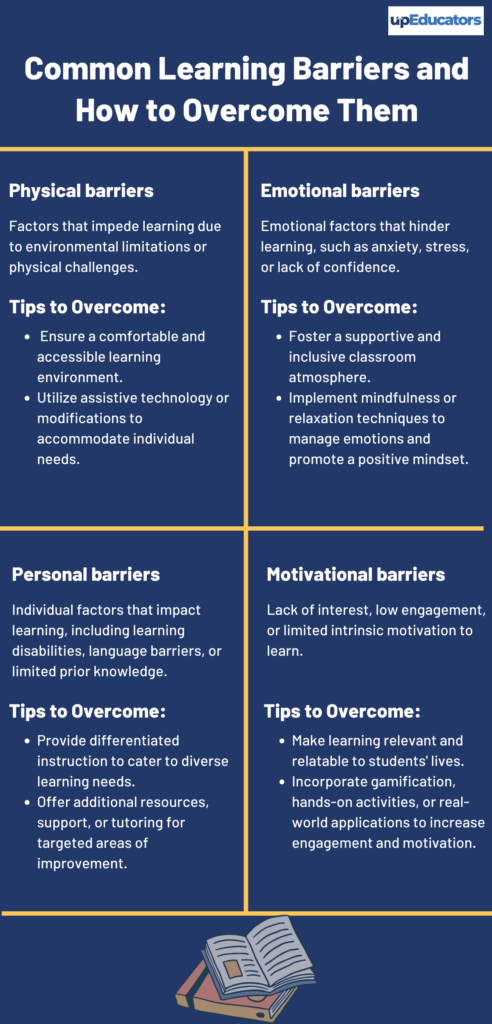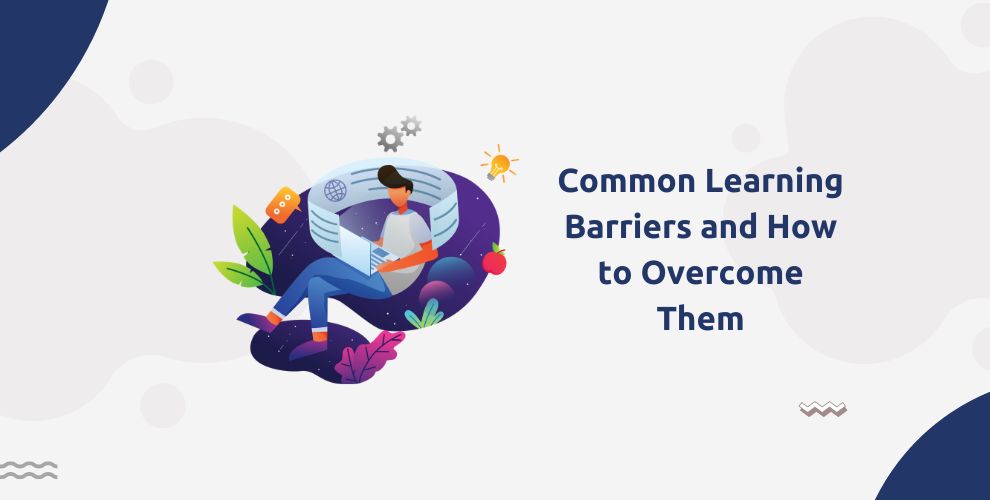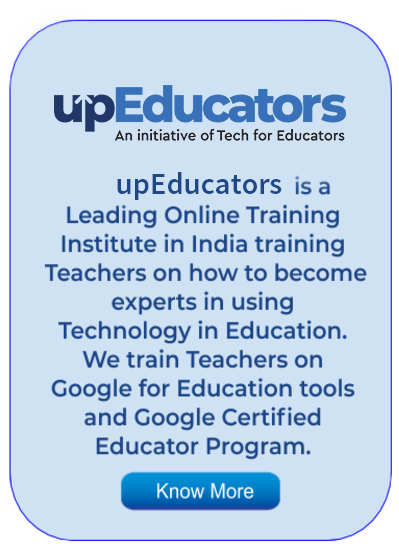A high school science teacher faced some issues in the classroom. Her school did not have enough teaching resources to provide her with the materials she needed to effectively teach her students. She did not have access to the lab equipment she needed to conduct experiments, and she had a limited number of textbooks.
She knew that she needed to overcome this barrier to provide her students with a quality education. She started to use technology to supplement her lessons, such as virtual labs and simulations. She also sought out resources from local organizations, such as science museums, which provided her with additional materials. She also started to collaborate with other teachers in her school, sharing resources and materials with them.
Her efforts paid off. Her students were more engaged and motivated to learn, and her class performance improved. Her school and administrators also noticed the improvement and provided her with more resources. She was glad that she took the initiative to overcome the physical barriers and provide her students with a quality education.

This kind of problem faced in the classroom is usually grouped under physical barriers in the classroom. A teacher faces many kinds of barriers in teaching. In this blog, we will look at 4 types of barriers in the classroom and how teachers can overcome them.
Physical Barriers
Ms Vineeta was a teacher who loved her job, but was faced with a physical barrier in the form of a smaller classroom than she was used to. This made it difficult for her to conduct lessons effectively, as students had limited space to move around and engage in activities. Ms Vineeta spoke to the school administration about the issue but was informed that no other classrooms were available. She took matters into her own hands, rearranging the classroom to create more space by moving desks and reorganizing supplies. This effort made a noticeable difference in student engagement and success.
Physical barriers can make learning difficult. Some physical barriers that teachers may face in the classroom include:
- Limited space: A classroom that is too small or overcrowded can make it difficult for teachers to move around and for students to comfortably participate in activities.
- Poor lighting: Poor lighting can cause eye strain and make it difficult for students to see the board or other visual aids.
- Poor acoustics: A classroom with poor acoustics can make it difficult for students to hear the teacher or for the teacher to hear students when they speak.
- Inadequate technology: A classroom that lacks sufficient technology, such as interactive whiteboards or computers, can limit the types of activities and instruction that a teacher can provide.
- Limited accessibility: A classroom that is not accessible to students with disabilities can make it difficult for them to fully participate in class and can create barriers to their learning.
Tips to Overcome
Here are some tips for teachers to overcome physical barriers in the classroom:
- Make use of available technology: If your classroom lacks certain technology, consider using alternatives such as a personal laptop or tablet to project images and videos onto the board.
- Create a comfortable learning environment: Rearrange the furniture in the classroom to create more space, and use curtains or blinds to control lighting.
- Use visual aids: Use posters, diagrams, and other visual aids to supplement your lessons and make them more engaging for students.
- Use different teaching methods: Incorporate a variety of teaching methods, such as group work, discussions, and hands-on activities, to make the most of the space and resources available.
- Provide support for students with disabilities: Work with special education teachers and provide accommodations such as large print materials, sign language interpreters, or assistive technology to support students with disabilities.
Emotional Barriers
Ms. Aishwarya loved teaching, but stress and anxiety made it difficult for her to be effective. Exhausted and struggling to focus, she was worried that she was failing as a teacher. Seeking support from colleagues and counseling, she learned self-care techniques and started taking time for herself. Incorporating mindfulness into her classroom routine, she helped her students reduce stress and focus. By prioritizing her emotional well-being, Ms. Aishwrya regained her love for teaching, becoming a role model for others struggling with similar challenges and inspiring her students to value their own emotional health.
Emotional barriers like stress and burnout lead to problems in effective learning. Here are some common emotional barriers that teachers may face in the classroom:
- Stress and burnout: Teaching can be a demanding and stressful profession, and dealing with difficult students, behaviour management, and administrative tasks can lead to feelings of burnout.
- Lack of confidence: A teacher may lack confidence in their abilities, which can lead to a lack of engagement and enthusiasm in the classroom.
- Isolation: Some teachers may feel isolated from colleagues and have a lack of support, which can lead to feelings of loneliness and dissatisfaction.
- Self-doubt: A teacher may have self-doubt and may question their abilities, which can lead to a lack of motivation and engagement.
- Inadequate training: A teacher may not have adequate training to deal with certain issues such as dealing with students with special needs, or dealing with diverse cultures which can lead to frustration.
Tips to Overcome
Here are some tips for teachers to overcome emotional barriers in the classroom:
- Prioritize self-care: Take care of your physical and emotional well-being by getting enough sleep, eating well, and engaging in regular exercise.
- Build a support network: Surround yourself with supportive colleagues, friends, and family members who can offer encouragement and guidance.
- Seek professional help: If you are experiencing emotional challenges that are affecting your work, consider seeking help from a therapist or counsellor.
- Learn from failure: Failure is a natural part of learning and growing as a teacher, try to learn from your mistakes and use them to improve your practice.
- Develop positive relationships with students: Build positive relationships with your students by getting to know them, showing interest in their lives, and providing positive feedback.
- Set realistic goals: Set realistic and achievable goals for yourself, and work towards them with a sense of purpose and direction.
Personal or Experiential Barriers
Mr Arun was an experienced teacher, but technology was a personal barrier that he struggled to overcome. He found it difficult to integrate new technology into his classroom, and this affected his teaching. His students were disengaged, and he knew that he was failing to provide them with the education they deserved. Seeking help from colleagues and attending technology training, Mr Arun gradually gained confidence in his ability to use technology in the classroom. By overcoming his personal barriers, he was able to improve his teaching and provide his students with a more engaging and effective learning experience.
Personal barriers can make teaching difficult. Here are some common personal or experiential barriers that teachers may face in the classroom:
- Limited life experiences: Teachers who have not been exposed to diverse cultures or backgrounds may struggle to relate to or understand their students.
- Limited subject matter expertise: Teachers who are not well-versed in a particular subject may struggle to provide effective instruction and engage students in learning.
- Personal biases: Teachers may have personal biases that can affect their ability to connect with and effectively teach students from diverse backgrounds.
- Limited understanding of students with special needs: Teachers may not have the training or experience to effectively teach students with special needs, and may struggle to provide accommodations and support.
- Limited understanding of technology: Teachers may not be familiar with technology or may not be able to integrate it effectively into their instruction, which can limit their ability to engage students and provide effective instruction.
Tips to Overcome
Here are some tips for teachers to overcome personal or experiential barriers in the classroom:
- Seek out professional development: Look for opportunities for professional development that can help you gain the knowledge, skills, and expertise you need to effectively teach your students.
- Learn about different learning styles: Learn about different learning styles, and try to adapt your teaching methods to accommodate different learners.
- Seek support: Seek support from colleagues, mentors, or other professionals who can offer guidance and advice on how to effectively teach students from diverse backgrounds.
- Create a positive and inclusive classroom culture: Create a positive and inclusive classroom culture that values and respects diversity and promotes equity.
- Learn about students with special needs: Seek out professional development and resources that can help you understand and effectively teach students with special needs.
- Learn about technology: Seek out professional development and resources that can help you understand and effectively integrate technology into your instruction.
Motivational Barriers
Mr. Roshan, a devoted teacher, faced a motivational barrier caused by the limited professional development opportunities available at his school. He felt his teaching was becoming stagnant and struggled to keep his students engaged in class. This led to a loss of confidence in his teaching abilities and a feeling of letting his students down. To overcome this, he took initiative and sought out professional development opportunities outside of school by attending workshops and online courses. This helped him gain confidence and develop new teaching strategies, resulting in more effective teaching and improved student engagement in his class.
Motivational barriers can result in disengaged classroom and ineffective learning. Here are some common motivational barriers that teachers may face in the classroom:
- Lack of recognition: Teachers may feel undervalued and unrecognized for their hard work, which can lead to feelings of demotivation.
- Burnout: Teachers may experience burnout from the demands of the profession, which can lead to feelings of exhaustion and apathy.
- Unmotivated students: Teachers may struggle to engage and motivate students who are disengaged or uninterested in learning.
- Negative feedback: Teachers may receive negative feedback from students, parents, or administrators, which can lead to feelings of demotivation.
- Limited resources: Teachers may lack the resources they need to effectively teach their students, which can lead to feelings of frustration and demotivation.
- Limited professional development: Teachers may not have access to professional development opportunities, which can limit their ability to improve their practice and feel motivated in their work.
Tips to Overcome
Here are some tips for teachers to overcome motivational barriers in the classroom:
- Take care of your well-being: Take care of your physical and emotional well-being by getting enough sleep, eating well, and engaging in regular exercise.
- Engage and motivate students: Engage and motivate students by making your lessons interesting, relevant, and interactive.
- Advocates for resources: Advocate for the resources you need to effectively teach your students, such as technology, materials, or support services.
- Seek out professional development: Look for opportunities for professional development and learning, and take advantage of those that align with your goals and interests.
- Build positive relationships: Build positive relationships with colleagues, administrators, and other professionals, and seek out their support and guidance.
Classroom barriers come in many forms such as physical, emotional, personal or experiential, and motivational. These barriers can affect a teacher’s ability to provide effective instruction and engage students in learning. To overcome these barriers, teachers should make use of available resources, seek out professional development, and build positive relationships with colleagues, administrators, and students. Teachers should also prioritize self-care, reflect on their practice, and set realistic goals for themselves. With the right strategies and support, teachers can overcome the barriers they face in the classroom and create a positive and effective learning environment for their students.
Author: This article is written by Samiya Rashid for upEducators blog.




